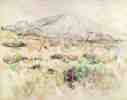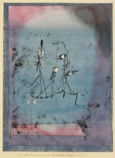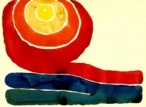

When made opaque with white, watercolor is generally called gouache or bodycolor. Tempera is another exception.
Colors are usually applied and spread with brushes, but other tools can also used. The most common techniques for applying watercolor are called wet-on-dry and wet-on-wet, along with the dry brush techniques dry-on-dry and dry-on-wet. Colors can be removed while still wet, to various degrees by blotting.
Most watercolor painting is done on paper, but other absorbent grounds can also be employed. The papers most favored by those who paint with watercolor is white, very thick, with high rag content, and has some tooth.
"Watercolor" is the American spelling. "Watercolour" is the British spelling.
Examples of works in watercolor:
Listed chronologically by artist's birth year
Use ctrl-F (PC) or command-F (Mac) to search for a name
Albrecht Dürer (German, 1471-1528), A Young Hare, 1502, watercolor and gouache on paper, 25 x 23 cm, Graphische Sammlung, Albertina, Vienna. Albrecht Dürer is considered one of the pioneers in the use of watercolors. See Northern Renaissance.
Albrecht Dürer, The Large Piece of Turf, 1503, watercolor and gouache on yellowed paper, 41 x 32 cm, Graphische Sammlung, Albertina, Vienna.
![]()
Indian, Mughal
dynasty, A Ruler on Horseback Leading an Army across a
Battlefield, from the Tarikh-i Alfi, c. 1592-94,
opaque watercolor on paper, heightened
with gold;
Persian text
in nastaliq script, Worcester Art Museum, MA.

Sally Miller (American, Litchfield, CN),
Mourning picture, c. 1811, silk painted
with watercolors and ink, 28 x 32
3/8 inches (71.12 x 82.23 cm), Metropolitan Museum of Art, NY.

Joseph Mallord William Turner (English, 1775-1851),
Conway Castle, North Wales, 1798, watercolor and gum
arabic with graphite
underdrawing, 21 1/8 inches
x 30 1/8 inches (53.6 x 76.7 cm), J. Paul Getty Museum, Malibu,
CA. See Romanticism.

Joseph Mallord William Turner, The Lake of Zug, 1843, watercolor with
gouache and colored
chalks, over traces
of graphite; extensive
scraping with penknife, 11 3/4 x 18 3/8 inches (29.8 x 46.6 cm),
Metropolitan Museum of Art, NY.

James Duffield Harding (English, 1797 or
98 - 1863), Twickenham, 1839, drawing and monochromatic
watercolor on paper, 27.0 x 38.4
cm, Tate Gallery, London.

Ferdinand-Victor-Eugène Delacroix
(French, 1798-1863), Saada, the Wife of Abraham Benchimol, and Préciada,
One of Their Daughters, 1832, watercolor over graphite,
8 3/4 x 6 3/8 inches (22.2 x 16.2 cm), Metropolitan Museum of
Art, NY. See Romanticism.
Ferdinand-Victor-Eugène Delacroix, Strolling Players, 1833, watercolor, 9 3/4 x 7 1/4 inches (24.8 x 18.4 cm), Los Angeles County Museum of Art.

Richard Parkes Bonington (French, born England,
1802-1828), Verona, Piazza dell'Erbe, c. 1826-7,
watercolor and pencil
on paper, 20.6 x 26.5 cm, Tate
Gallery, London.

Dante Gabriel Rossetti (English, 1828-1882),
Lady Lilith, 1867, watercolor, bodycolor
and gum, 20 3/16 x 17
5/16 inches, Metropolitan Museum of Art, NY. See Pre-Raphaelite Brotherhood.

Winslow Homer (American, 1836-1910), Boys and Kitten, 1873, watercolor and
gouache over graphite on cream wove paper, Worcester Art Museum, MA. Among
his first efforts with watercolor, this picture
was painted while Homer was vacationing in Gloucester, Massachusetts.
His use of watercolor was so innovative and expressive
that he greatly contributed to its becoming accepted as a fine arts medium.
See realism.
Winslow Homer, Ship's Boat, 1883, watercolor, New Britain Museum of Art, CT.

Winslow Homer, After from the Hunt, 1892, watercolor,
16 x 21 inches (40.6 x 53.3 cm), Los Angeles County Museum of
Art.

Anton Mauve (Dutch, 1838-1888), Entering the Fold, c. 1885-8, drawing and watercolor on paper,
505 x 60.3 cm, Tate Gallery, London. Anton Mauve was an early
influence on Vincent van
Gogh. This prolific and popular Dutch realist painter's wife was van Gogh's
cousin. Mauve and van Gogh worked together for a short time.
See pastoral.

Paul Cézanne (French, 1839-1906),
Foliage, 1895-1900, watercolor and pencil on paper,
17 5/8 x 22 3/8 inches (44.8 x 56.8 cm), Museum of Modern Art,
NY. See Post-Impressionism.

Paul Cézanne, Still Life, about 1900, watercolor and
graphite, 18 15/16 x 24
7/8 inches (48 x 63.1 cm), J. Paul Getty Museum, Malibu, CA.
See still
life.
Paul Cézanne, Mont Sainte-Victoire Seen from Les Lauves, 1901-1906, pencil and watercolor, 18 7/8 x 12 1/4 inches (48 x 31 cm), private collection.

Paul Cézanne, Le
Mont Sainte-Victoire, 1902-1906, pencil
and watercolor on white paper,
16 3/4 X 21 3/8 inches (42.5 x 54.3 cm), Museum of Modern Art,
New York.

Henri-Edmond Cross (French, 1856-1910), Landscape with Stars, watercolor over
pencil on paper,
9 5/8 x 12 5/8 inches (20.5 x 32.5 cm), Metropolitan Museum of
Art, NY. See Neo-Impressionism
and nocturne.

John Singer Sargent (American, born in Italy,
1856-1925), Venetian Fishing Boats, c. 1904, pencil and watercolor on
paper, 48.9
x 34.9 cm, Tate Gallery, London.
![]()
John Singer Sargent, Muddy Alligators, 1917, watercolor over
graphite on off-white
wove paper,
Worcester Art Museum, MA.
Childe Hassam (American, 1859-1935). See American Impressionism and Ten American Painters.

Maurice Brazil Prendergast (American, born
Newfoundland, 1859-1924), Large Boston Public Garden Sketchbook: The Huntington
Avenue Streetcar, 1895-1897, watercolor over pencil,
14 1/8 x 11 1/8 inches (35.8 x 28.4 cm), Metropolitan Museum
of Art, NY. See The
Eight.

Maurice Brazil Prendergast, Low
Tide, Beachmont, c. 1902-4, watercolor over graphite
and coal on off-white wove paper,
Worcester Art Museum, MA.

Wasily Kandinsky (Russian, 1866-1944), Watercolor (Number 13), 1913, watercolor
on paper, 12 5/8 x 16 1/8 inches
(32.1 x 41 cm), Museum of Modern Art, NY.

Emil Nolde (German, 1867-1956), Papuan Head, 1914, watercolor on paper, 19 7/8 x 14 3/4 inches (50.4
x 37.5 cm), Museum of Modern Art, NY.

John Marin (American, 1870-1953), Brooklyn Bridge, c. 1912, watercolor
and charcoal on paper,
18 5/8 x 15 5/8 inches (47.3 x 39.7 cm), Metropolitan Museum
of Art, NY.

Paul Klee (Swiss, 1879-1940), Twittering Machine, 1922, watercolor
and pen and ink
on oil transfer
drawing
on paper, mounted
on cardboard, 25 1/4
x 19 inches (63.8 x 48.1 cm), Museum of Modern Art, NY. See Bauhaus.

Francis Picabia (French, 1879-1953), Conversation I, 1922, watercolor and
pencil on paper,
59.5 x 72.4 cm, Tate Gallery, London.
Charles Demuth (American, 1883-1935), Daisies, 1925, watercolor, New Britain Museum of Art, CT.

Georgia O'Keeffe (American, 1887-1986), Evening Star, III, 1917, watercolor on
paper, 8 7/8 x 11 7/8 inches (22.7
x 30.4 cm), Museum of Modern Art, NY. See nocturne.

Egon Schiele (Austrian, 1890-1918), Seated Woman, Back View, 1917, watercolor,
gouache and pencil on paper,
18 1/4 x 11 3/4 inches (46.4 x 29.8 cm), Metropolitan Museum
of Art, NY. See Expressionism.
Stuart Davis (American, 1892-1964), Hoboken, 1916, watercolor, published in the Liberator 1 (August 1918), Library of Congress, Washington, DC.

George Grosz (German, worked there and in
USA, 1893-1959), A Married Couple, 1930, watercolor on paper,
66.0 x 47.3 cm, Tate Gallery, London. See Expressionism.

John Steuart Curry (American, 1897-1946),
Fire Diver, 1934, watercolor on paper
mounted on board, 22 1/2
x 15 1/2 inches, Kemper Museum of Contemporary Art, Kansas City,
MO. See movement
and vertical.
Also see binder, earth art, Index of American Design, seascape, stain, stain removal, wash, water gilding, watermark, waterproof, waterscape, and water-soluble.
https://inform.quest/_art